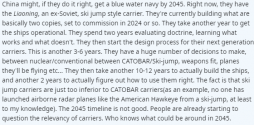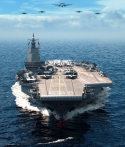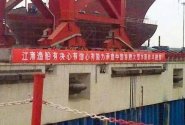You are using an out of date browser. It may not display this or other websites correctly.
You should upgrade or use an alternative browser.
You should upgrade or use an alternative browser.
CV-18 Fujian/003 CATOBAR carrier thread
- Thread starter Jeff Head
- Start date
Hendrik_2000
Lieutenant General
my opinion is at this point PLAN should start working on a second 003 type carrier, so it could maybe get two CATOBAR carriers before 2030.
Following that logic a future CV could as well be named 'Hebei' in recognition of the invasion by the Eight Nation Alliance during the Boxer Rebellion, and the resulting occupations and looting (e.g. the sacking of the Summer Palace) in and around Beijing and Tianjin within the province.The naming is based on major naval battles/wars and their aftermath in Chinese history - Liaoning for the major naval battle of the first Sino-Japanese war (decisive Chinese naval defeat, destruction of the Beiyang fleet, lost control of all surrounding seas), Shandong for the Siege of Weihaiwei and Lushun massacre (decisive Chinese army defeat, major Japanese army presence in Shandong peninsula, 20-30K civilian murdered, Beijing directly threatened, Korea peninsula lost, Taiwan ceded to Japan); Fujian for Battle of Fuzhou (decisive French victory, complete destruction of the Fujian fleet with 0 French ship losses, Taiwan strait blockaded, Penghu Islands and Keelung ceded). 004 will likely be Guangdong for the first and second opium wars (HK ceded for 150 years, first major sign China was a fish and not a butcher in the Imperialist 19th century, kicked off century of humiliation). 005 will likely be Jiangsu for the Treaty of Nanjing.
It's easy in the excitement of new strength to forget the bloody and painful lessons that were a mainstay not that long ago. There's still a long road ahead, and we are all witnesses.
Shilao and gang talked about their experience watching growth of PLA since they were kids. Xi recalls asking his parents why China doesn't have a carrier and his parents told him "one day Jiangnan Shipyard will build us one". Shilao recalls when 112 Harbin (052 lead ship) was launched in the 90s he went up to someone in PLAN to ask for their thought and he answered "what is this crap?!" and complained about lack of VLS and CIWS just like military fans.
Coming around to today, they said those jokes you are seeing today: the one where someone photoshopped Fujian to have a ramp or Shandong making fun of Fujian's flat cheat, those jokes are only funny because Fujian exists. If you ask kids today who grew up in a world where J-20 is flying overhead and Liaoning and Shandong are out at sea what they think of J-35 and Fujian they would just shrug and say well, that's normal isn't it?
They finished with this poem about the rapidly escalating tastes of PLA watchers:
当初航母盼成狗,如今滑跃还嫌丑。
电磁弹射来服役,又嫌不是核动力。
航母装上反应堆,再盼聚变显神威。
聚变动力不能飞,军迷还是不敢吹。
聚变终于来碰面,张口又要歼星舰。
Coming around to today, they said those jokes you are seeing today: the one where someone photoshopped Fujian to have a ramp or Shandong making fun of Fujian's flat cheat, those jokes are only funny because Fujian exists. If you ask kids today who grew up in a world where J-20 is flying overhead and Liaoning and Shandong are out at sea what they think of J-35 and Fujian they would just shrug and say well, that's normal isn't it?
They finished with this poem about the rapidly escalating tastes of PLA watchers:
当初航母盼成狗,如今滑跃还嫌丑。
电磁弹射来服役,又嫌不是核动力。
航母装上反应堆,再盼聚变显神威。
聚变动力不能飞,军迷还是不敢吹。
聚变终于来碰面,张口又要歼星舰。
Equation
Lieutenant General
Yes, a Jai Hind dream! Careful now, the Indian news agency might use this as evidence that China's type 003 aircraft carrier is a 'fake'.
Elevators are large heavy moving pieces that are necessarily held in place in a manner that is mechanically highly disadvantageous. As a result they are highly likely to be put out if action by shock. There are plenty of literature about how often one or more elevator becomes casualties. When an carrier suffers battle damage during World War II. There was one famous photo of USS enterprise experiencing a hit. The entire forward elevator is seen blown 400 feet up into the air.What would be the consequences of having one elevator out of action due to damage/malfunction/maintenance during wartime
By the way, is there any literature on how common elevator failures are in US carriers and how it affects their operations?




